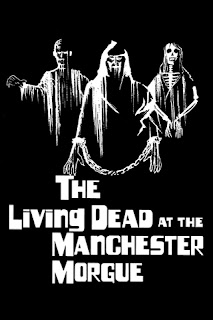The Living Dead at the Manchester Morgue
1965
Dir. Jorge Grau
AKA
Let Sleeping Corpses Lie
Don't Open the Window
Do Not Speak Ill of the Dead
Breakfast at the Manchester Morgue
The Living Dead at the Manchester Morgue is an Italian/Spanish co-production, largely shot in England, by a Spanish director, with a mostly British cast. George (Ray Lovelock) is an antique shop owner in swinging Sixties Manchester. He shuts up shop one fateful weekend to head off into the countryside to fix up an old house with some friends. On the way his motorbike is accidently reversed into by Edna (Cristina Galbo). She agrees to give him a lift to his destination, after she has been to visit her troubled sister Katie. George insists on driving Edna’s car, and bizarrely, she is okay with this. And so begins a night of terror for George and Edna. Hunted not only by an ever-growing horde of the living dead shuffling across the countryside, but also by the police, headed by a brutish Inspector who believes George and Edna are a couple of Satanists responsible for a gruesome death.
Dir. Jorge Grau
AKA
Let Sleeping Corpses Lie
Don't Open the Window
Do Not Speak Ill of the Dead
Breakfast at the Manchester Morgue
The Living Dead at the Manchester Morgue is an Italian/Spanish co-production, largely shot in England, by a Spanish director, with a mostly British cast. George (Ray Lovelock) is an antique shop owner in swinging Sixties Manchester. He shuts up shop one fateful weekend to head off into the countryside to fix up an old house with some friends. On the way his motorbike is accidently reversed into by Edna (Cristina Galbo). She agrees to give him a lift to his destination, after she has been to visit her troubled sister Katie. George insists on driving Edna’s car, and bizarrely, she is okay with this. And so begins a night of terror for George and Edna. Hunted not only by an ever-growing horde of the living dead shuffling across the countryside, but also by the police, headed by a brutish Inspector who believes George and Edna are a couple of Satanists responsible for a gruesome death.
Upon its initial release, The Living Dead at the Manchester Morgue was condemned as a video nasty. However, despite some genuinely grisly moments, uneven performances, awful dubbing and stop-start pacing, the film does contain a few interesting and thought-provoking elements. For one, it takes a distinctly ecological approach to explain how and why the dead are returning to life. Experimental ultra-sonic radiation used as pesticide is discovered to have effects on ‘primitive nervous systems’, such as new-born babies and the recently deceased, causing both to become flesh-hungry monsters. Watched in today’s current climate of awareness and concern for the environment, it acts as a cautionary tale warning of meddling with nature for our own gain.


Lurking amidst the carnage is also a smattering of social commentary on generational conflict. The younger characters are more liberal and progressive, while the older characters, particularly the gruff Irish Inspector (Arthur Kennedy), are more conservative and inflexible. Authority figures are untrustworthy, intolerant and openly prejudiced. The Inspector voices some derogatory, bigoted opinions about the youth of the day and their ideals. There's some unintentional hilarity when he shares his dated observations on city-life, youth culture, sexuality and drug abuse. The police are as much of a menace to George and Edna as the undead, and when they the inspector orders them to shoot to kill, it heightens the tension and the idea of generational conflict. One can’t help but be reminded of clashes between police and anti-war, civil-rights activists throughout the Sixties.
Many of the idyllic locations are shot in such a way as to render them sinister. Open countryside leaves nowhere for the characters to hide. Isolates them from help. The early scene in which George leaves Edna to go and ask for directions, echoes a similar moment in Romero’s Night of the Living Dead. Waiting by the car, Edna is attacked by a strange man, who turns out to be dead. Locked in the vehicle as the man bashes on the window, Edna’s plight is genuinely alarming. Since no one else saw the attack, they tell her she must have imagined it (!), belittling her into silence. Another taut and disturbing scene occurs when Edna’s sister Katie encounters the same dead man who attacks her creepy photographer boyfriend. The attack is captured on his camera; every time the flash lights up the scene, Katie (and the viewer) glimpse the bloody carnage in gruesome snippets.
With its nasty special effects packing a visceral punch, and its unexpected socio-political commentary, The Living Dead at the Manchester Morgue is a queasily taut, blood-splattered and (at times) gruelling yarn.



